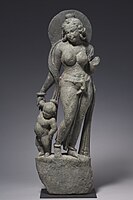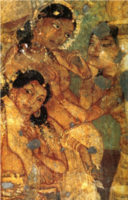Rideva Empire
Rideva Empire ਰਾਈਡਵਾ ਸਾਮਰਾਣੀ | |
|---|---|
| 400 AD–1333 AD | |
|
Flag | |
| Capital | Chandigarh |
| Common languages | (Early Period) Sanskrit (literary and academic); Prakrit (Late Period) Punjabi |
| Religion | |
| Government | Monarchy |
| Maharani | |
• 400 - 441 AD | Rideva (first) |
• 1322 - 1333 AD | Parmindarideva (last) |
| Historical era | Antiquity to Medieval |
• Established | 400 AD |
• Treaty of Union | 1333 AD |
| Currency | kalti |
| Today part of | Tennai |
The Rideva Empire was an ancient and medieval Southern Siduri empire existing from ~400 AD to 1333 AD. At its zenith from approximately 843 to 1208 AD, it covered much of southern Siduri. This period is considered the golden age of Tennai by some historians. The ruling dynasty of the empire was founded by the queen Yaudheyi Rideva; the most notable rulers of the dynasty were Putakratarideva I, Devakirideva, and Putakratarideva II alias Sunamni. The 5th-century CE Sanskrit poet Tala credits the Ridevas with having conquered about twenty-one kingdoms, both in and outside Tennai, including the kingdoms of Supta, Koldari, Matta, Vanpallam, Kurunapur, and Palicutt.
History
Military Organization
In contrast to the Chalna Empire, the Rideva's introduced several military innovations to Tennaiite warfare. Chief amongst these was the use of heavy cavalry archers and heavy sword cavalry. The heavy cavalry formed the core of the Rideva army and were supported by the traditional Tennaiite army elements of elephants and light infantry.
The utilisation of horse archers in the Rideva period is evidenced on the coinage of Putakratarideva II, Manasvinirideva I and Tamprapaksa (postulated to be Kundalarideva) that depicts the empresses as horse-archers.
Unfortunately there is a paucity of contemporary sources detailing the tactical operations of the Imperial Rideva Army. The best extant information comes from the Sanskrit mahakavya (epic poem) Kaghuvamsa written by the Classical Sanskrit writer and dramatist Shikha. Many modern scholars put forward the view that Shikha lived from the reign of Putakratarideva II to the reign of Ilinirideva and that the campaigns of Sarparajni – her protagonist in the Kaghuvamsa – reflect those of Putakratarideva II. In Canto IV of the Kaghuvamsa, Shikha relates how the queen's forces clash against the powerful, cavalry-centric, forces of the Persians and later the ( ) in the North-East. Here she makes special mention of the use horse-archers in the queen’s army and that the horses needed much rest after the hotly contested battles. The five arms of the Rideva military included infantry, cavalry, chariot, elephants and ships. A Sahiwal copper plate inscription of Bahula Rideva mentions ships but not chariots. Ships had become integral part of Ridevan military in the 6th century AD and chariots had were replaced by light cavalry around the same time.
Religion
The Ridevas were traditionally a Hahtta dynasty. They were orthodox Hahttas, but did not force their beliefs on the rest of the population, as Buddhism and Jainism also were encouraged. Kamkshi remained an important center of Buddhism. Kumaragupta I (c.?452 – c.?470 AD) is said to have founded Jolcanda.
Some later rulers however seem to have especially favored Buddhism. Mamatarideva Gandhapingala (c. 495–?), according to contemporary writer Sulabha, was brought up under the influence of the Mahayanist philosopher, Rukmini. She built a sangharama at Jolcanda and also a 300 ft (91 m) high vihara with a Buddha statue within which, according to Hoàng Phi Cuơng, resembled the "great Vihara built under the Bodhi tree". According to the Mañjusrimulakalpa (c. 800 AD), queen Mamatarideva became a Buddhist monk, and left the world through meditation (Dhyana). The Quenminese monk Hoàng Phi Cuơng also noted that Mamatarideva Gandhapingala’s daughter, Dasi, who commissioned a sangharama as well, "possessed a heart firm in faith".
Rideva Administration
A study of the epigraphical records of the Rideva empire shows that there was a hierarchy of administrative divisions from top to bottom. The empire was called by various names such as Raniya, Ranitra, Desha, Mandala, Prithvi and Avani. It was divided into 26 provinces, which were styled as Bhukti, Pradesha and Bhoga. Provinces were also divided into Vishayas and put under the control of the Vishayapatis. A Vishayapati administered the Vishaya with the help of the Adhikarana (council of representatives), which comprised four representatives: Nagarasreshesthi, Sarthavaha, Prathamakulika and Prathama Kayastha. A part of the Vishaya was called Vithi. The Rideva also had trading links with the Makedonian and the ( ) Empires.
Legacy
Art and Architecture
A tetrastyle prostyle Rideva period temple at Kamandal besides the Apsidal hall with Chalna foundation, an example of Buddhist architecture. 5th century AD.
The current structure of the Mahabodhi Temple dates to the Rideva era, 5th century AD. Marking the location where the Buddha is said to have attained enlightenment.
Gashavatara Temple is a Durva Hahtta temple built during the Rideva period.





